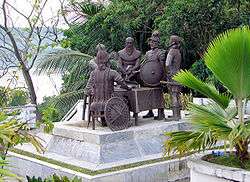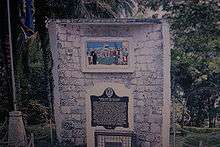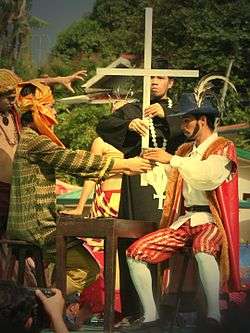Sandugo

The Sandugo was a blood compact, performed in the island of Bohol in the Philippines, between the Spanish explorer Miguel López de Legazpi and Datu Sikatuna the chieftain of Bohol on March 16, 1565, to seal their friendship as part of the tribal tradition. This is considered as the first treaty of friendship between the Spaniards and Filipinos. "Sandugo" is a Visayan word which means "one blood".[1]
The Sandugo is depicted in both the provincial flag and the official seal of the government in Bohol.[2] It also features the image of the blood compact. The top of the seal explains the history behind the Sandugo event that occurred in Bohol, the fleet and the location where the Spaniards anchored and the place where the treaty was conducted which was dated on March 16, 1565.[3]
History

In 1521, Portuguese explorer Ferdinand Magellan became the first person from Europe to reach Asia by sailing west, a voyage of which he would meet an untimely death in the island of the Philippines. Spain sent expeditions to colonize the East Indies in their competition with Portugal to seize control over the spice trade. However, all of these expeditions failed. It was not until Miguel López de Legazpi, sailing from Mexico with five ships and five hundred men, reached the Philippines in 1565 and a Spanish settlement was established.[4] López de Legazpi was greeted by hostile Muslim tribes opposing a foreign invasion. His attempt to land on the island of Cebu resulted in the death of one of his soldiers prompting him to explore another island and seek trade with various tribes.[4]

Sailing south toward the island of Mindanao, López de Legazpi's fleet encountered highwinds forcing them to sail northward to the island of Bohol. There, he captured a vessel from Borneo whose Malay sailors informed the Spaniards that the natives inhabiting the region traded with people from Borneo and Indonesia.[4] Arriving in Bohol, López de Legazpi noticed the hostility of the people. The Malayan servant explained that such hostility was due to the expeditions conducted by the Portuguese from the Moluccas islands. In 1563, Portuguese fleets arrived in Visayan waters and enslaved about 1,000 inhabitants.[4] López de Legazpi, with the help of the Malayan sailor, explained to the tribes in Bohol that they were not Portuguese and that they had come to the islands to trade. Upon learning this, the chieftains and their tribes became friendlier and welcoming to the Spaniards.[4]
Ceremony

The Sandugo began with the arrival of Miguel López de Legazpi in Bohol in 1565 and the establishment of allegiance by Datu Sikatuna to the king of Spain. They made a cut on their left arm with a dagger and poured their blood into a cup filled with wine, which they both drank in honour of their friendship.[5] The inscription at a monument in Tagbilaran City describes the event:
| “ | About the middle of March 1565, the fleet of Captain General Miguel López de Legazpi anchored along these shores. In the course of this visit, López de Legazpi entered into a blood compact with Datu Sikatuna for the purpose of insuring friendly relations between the Spaniards and Filipinos. | ” |
It added that the compact was performed as part of the tribal tradition.
| “ | Each of the two leaders made a small cut in his arm, drew a few drops of blood from the incision, mixed it with wine, and drank the goblet containing the blood of the other. Thus was the first bond of friendship between Filipinos and Spaniards. | ” |
In his report to Philip II, López de Legazpi wrote:
| “ | It is observed in the following manner: one from each party draws two or three drops of blood from his own arm or breast and mixes them in the same cup, with water or wine. Then the mixture must be divided equally between two cups and neither person may depart until both cups are alike drained.[4] | ” |
Tradition
By performing a blood compact, it preserves the bond of friendship between two tribes. This ceremony was the first treaty of friendship between the natives, and the Spaniards.[5] In honor of this ceremony, the former President of the Philippines Elpidio Quirino established the Order of Sikatuna, a presidential decoration conferred upon politicians.[1] Juan Luna, a Filipino painter, depicted this event in his painting entitled The Blood Compact (Spanish: El Pacto de Sangre) in 1883. El Pacto de Sangre obtained the first prize in Paris in 1885 and at the Louisiana Purchase Exposition of St. Louis in 1904.[6] At that period, it was an important part for tribes to perform the sandugo as part of the peace process.[7] A monument was constructed in Tagbilaran City by the Philippine Historical Committee and the National Historical Institute.[8][9][10]
See also
References
- 1 2 History of Bohol www.bohol.gov.ph Retrieved November 16, 2006
- ↑ Provincial Flag and Seal www.bohol.gov.ph Retrieved November 16, 2006. Archived October 11, 2006, at the Wayback Machine.
- ↑ Tagbilaran City Seal www.tagbilaran.gov.ph Retrieved November 16, 2006.
- 1 2 3 4 5 6 Readings From Bohol's History www.aenet.org, Source: Philippine Political and Cultural History. Volume I. Gregorio F. Zaide Retrieved 15 November 2006.
- 1 2 Sandugo Festival Bohol www.philippinecountry.com Retrieved November 16, 2006.
- ↑ Juan Luna www.jose-rizal.eu Retrieved November 23, 2006. Archived July 21, 2011, at the Wayback Machine.
- ↑ Cajes, Alan. A Brief History of Bohol www.aybpm.freeservers.com Retrieved 22 November 2006.
- ↑ Fuentes, Chito. Blood Compact controversy boils news.inq7.net Retrieved December 2, 2006. Archived October 1, 2012, at the Wayback Machine.
- ↑ Bantugan, Danilo. City Hall Notes www.boholchronicle.com August 13, 2006. Retrieved 28 November 2006. Archived September 28, 2007, at the Wayback Machine.
- ↑ Cabalit, Jorge. Viewpoints www.boholchronicle.com July 23, 2006. Retrieved November 28, 2006. Archived March 19, 2009, at the Wayback Machine.
Publications
- Agoncillo, Teodoro A. History of the Filipino People. GAROTECH Publishing, 1990 (8th Edition).
- Arcila, José S. Rizal and the Emergence of the Philippine Nation. 2001 revised edition.
- Constantino, Renato. The Philippines: A Past Revisited. Tala Publishing Series, 1975.
- Corpuz, Onofre D. The Roots of the Filipino Nation. 1989.
- Scott, William Henry. Barangay: Sixteenth-Century Philippine Culture and Society. AdMU: 1994.
- Zaide, Gregorio F. Great Filipinos in History: An Epic of Filipino Greatness in War and Peace. Verde Bookstore, 1970.
- Zaide, Gregorio. Dagohoy: Champion of Philippine Freedom. Manila: Enriquez, Alduan and Co., 1941.
External links
| Wikimedia Commons has media related to Blood Compact Monument. |
- Blood Compact Site on SerialTripper.com
